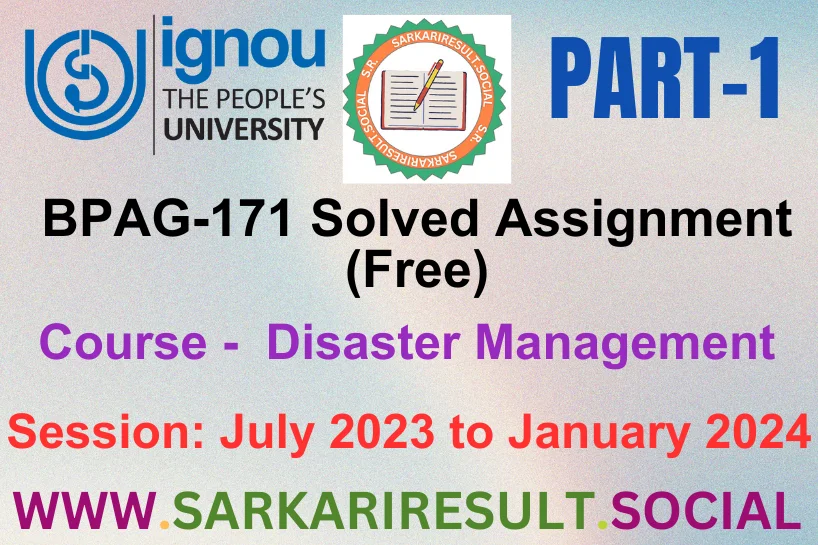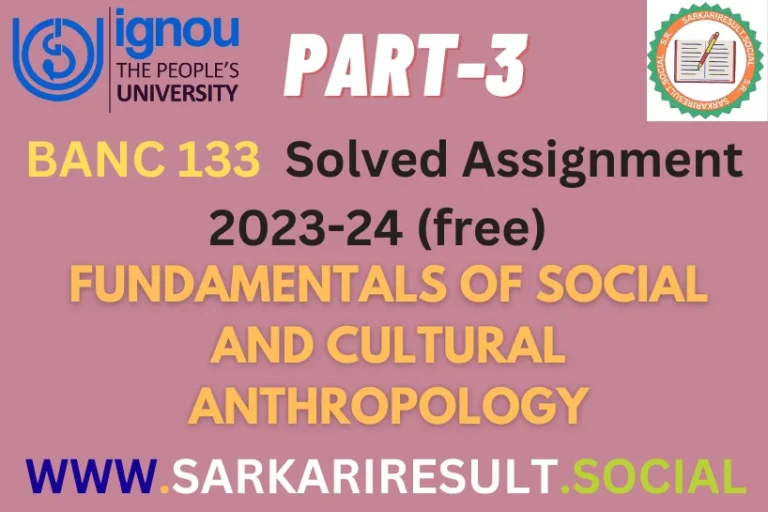BPAG 171 SOLVED IGNOU ASSIGNMENT FREE PART 1

Welcome to the BPAG 171 SOLVED IGNOU ASSIGNMENT FREE PART 1 TMA. Assignment A offers two insightful questions. In about 500 words each, explore the diverse types of natural disasters and delve into the key aspects of community-based disaster management. Our concise responses provide a clear and efficient path for comprehending these critical aspects of disaster management, ensuring a successful completion of your assignments. Our IGNOU Solved Assignments 2024 for this section serve as your creative guide.

Answer the following questions in about 500 words each.
Q.1 Discuss the various types of natural disasters.
Ans. Natural disasters are catastrophic events caused by natural processes of the Earth. These events result in widespread destruction, loss of life, and disruption of communities. There are several types of natural disasters, each with unique characteristics and impacts.
1. Earthquakes:
– Causes: Earthquakes occur due to the movement of tectonic plates beneath the Earth’s surface. When these plates release accumulated stress, it results in seismic waves, causing the ground to shake.
– Impacts: Earthquakes can lead to building collapses, landslides, and tsunamis if they occur underwater. The intensity is measured on the Richter scale.
2. Hurricanes (Cyclones or Typhoons):
– Causes: These are intense tropical storms with strong winds and heavy rainfall. They form over warm ocean waters and gain strength as they move.
– Impacts: Hurricanes can cause storm surges, flooding, and extensive damage to coastal areas. Categories are determined by wind speed, with Category 5 being the most severe.
3. Floods:
– Causes: Floods result from excessive rainfall, storm surges, or the sudden melting of snow. Poor drainage systems and deforestation can exacerbate flooding.
– Impacts: Floods lead to the inundation of land, damaging infrastructure, displacing populations, and causing waterborne diseases. Flash floods occur suddenly with little warning.
4. Tornadoes:
– Causes: Tornadoes are violent windstorms characterized by a twisting, funnel-shaped cloud. They form when warm, moist air meets cold, dry air.
– Impacts: Tornadoes can cause massive destruction in a localized area, destroying buildings and uprooting trees. The Enhanced Fujita scale measures tornado intensity.
5. Volcanic Eruptions:
– Causes: Volcanic eruptions occur when magma, ash, and gases erupt from a volcano. The Earth’s mantle forces molten rock to the surface.
– Impacts: Volcanic eruptions can result in lava flows, ash clouds, and pyroclastic flows. The impact depends on the eruption’s scale and proximity to human settlements.
6. Droughts:
– Causes: Droughts are prolonged periods of abnormally low rainfall. They can be triggered by natural variability or human activities like deforestation and excessive water use.
– Impacts: Droughts lead to water shortages, crop failure, and food insecurity. They can have long-lasting effects on ecosystems and communities.
7. Wildfires:
– Causes: Wildfires occur when dry conditions, high temperatures, and ignition sources such as lightning or human activities lead to uncontrolled fires.
– Impacts: Wildfires can devastate vast areas of land, destroy homes, and result in loss of life. Smoke from wildfires poses health risks and affects air quality.
8. Landslides:
– Causes: Landslides happen when there is a sudden and fast movement of a large amount of earth material down a slope.
– Impacts: Landslides can bury homes, infrastructure, and roads, leading to loss of life and economic disruption.
9. Extreme Heatwaves:
– Causes: Heatwaves occur when temperatures rise significantly above average for a prolonged period, often due to high-pressure systems.
– Impacts: Heatwaves can cause heat-related illnesses, stress power grids, and lead to drought conditions.
10. Snowstorms and Blizzards:
– Causes: These occur in cold climates when moist air meets a mass of cold, dry air, resulting in heavy snowfall and strong winds.
– Impacts: Snowstorms can disrupt transportation, cause power outages, and pose risks to health and safety.
In conclusion, the diverse array of natural disasters showcases the Earth’s dynamic and sometimes hazardous nature. Understanding the causes, impacts, and potential mitigations for these events is crucial for disaster preparedness and response efforts.
Q.2 Highlight the key aspects of the community based disaster management.
Ans. Community-Based Disaster Management (CBDM) is a holistic and participatory approach that emphasizes the active involvement of local communities in all phases of disaster management—prevention, preparedness, response, recovery, and mitigation. This strategy recognizes the unique strengths, knowledge, and capacities of communities in dealing with disasters. Here are key aspects of CBDM:
1. Community Empowerment:
– Participatory Decision-Making: CBDM involves communities in decision-making processes, ensuring that local knowledge and needs are considered.
– Capacity Building: Communities are empowered through training programs, workshops, and education to enhance their ability to cope with disasters independently.
2. Risk Assessment and Planning:
– Local Risk Assessment: CBDM encourages communities to conduct their own risk assessments, considering local vulnerabilities, resources, and hazards.
– Community Action Plans: Based on the assessment, communities develop customized action plans outlining roles, responsibilities, and resources required during disasters.
3. Early Warning Systems:
– Community-Based Warning Systems: Engaging communities in the design and implementation of warning systems ensures timely communication of potential threats.
– Local Communication Networks: CBDM promotes local communication networks, reducing dependency on centralized systems.
4. Preparedness and Training:
– Drills and Simulations: CBDM facilitates regular drills and simulations, preparing communities for effective responses during disasters.
– First Aid and Emergency Response Training: Communities are trained in basic first aid, search and rescue, and other skills crucial for initial response.
5. Resource Mobilization:
– Local Resources: CBDM emphasizes utilizing local resources and expertise for disaster response and recovery.
– Community-Based Funds: Establishing community-based funds ensures financial resources for immediate response and recovery efforts.
6. Inclusive Approach:
– Vulnerable Populations: CBDM addresses the needs of vulnerable groups, ensuring the inclusivity of women, children, elderly, and differently-abled individuals.
– Cultural Sensitivity: Understanding and respecting local customs and cultural practices enhances the effectiveness of CBDM.
7. Communication and Networking:
– Community Networks: CBDM promotes the formation of community networks, fostering cooperation and information sharing.
– Linkages with Authorities: Establishing communication channels with local authorities enhances coordination and support.
8. Post-Disaster Recovery and Rehabilitation:
– Community-Led Reconstruction: CBDM involves communities in planning and implementing recovery efforts, fostering a sense of ownership and resilience.
– Psychosocial Support: Addressing the psychological impact of disasters, CBDM integrates psychosocial support into recovery programs.
9. Advocacy and Awareness:
– Community Advocacy: CBDM encourages communities to advocate for their needs and priorities at various levels of governance.
– Public Awareness Campaigns: Raising awareness about disaster risks and the importance of preparedness fosters a culture of safety.
10. Learning and Adaptation:
– Feedback Mechanisms: CBDM incorporates feedback loops, enabling communities to reflect on experiences and continuously improve their strategies.
– Adaptive Management: Learning from past disasters, communities adapt their plans and strategies to evolving risks.
11. Government and NGO Collaboration:
– Partnerships: CBDM emphasizes collaboration between local communities, government agencies, and non-governmental organizations to pool resources and expertise.
– Policy Advocacy: Communities engage in advocating for policies that support their resilience-building efforts.
In conclusion, CBDM is a community-driven approach that recognizes the centrality of local knowledge and resources in disaster management. By empowering communities, building capacities, and fostering inclusive practices, CBDM enhances resilience and reduces vulnerabilities, creating a more sustainable and effective approach to disaster risk reduction.
Also See This: BPAG 171 SOLVED IGNOU ASSIGNMENT FREE PART 2






